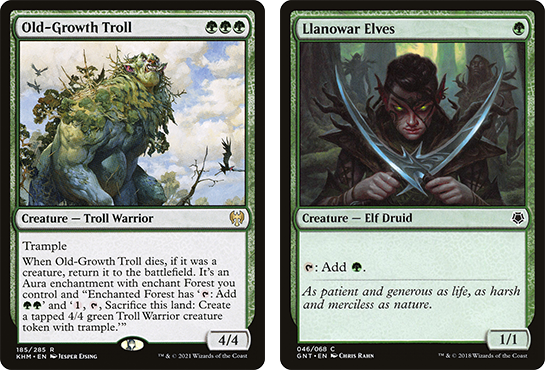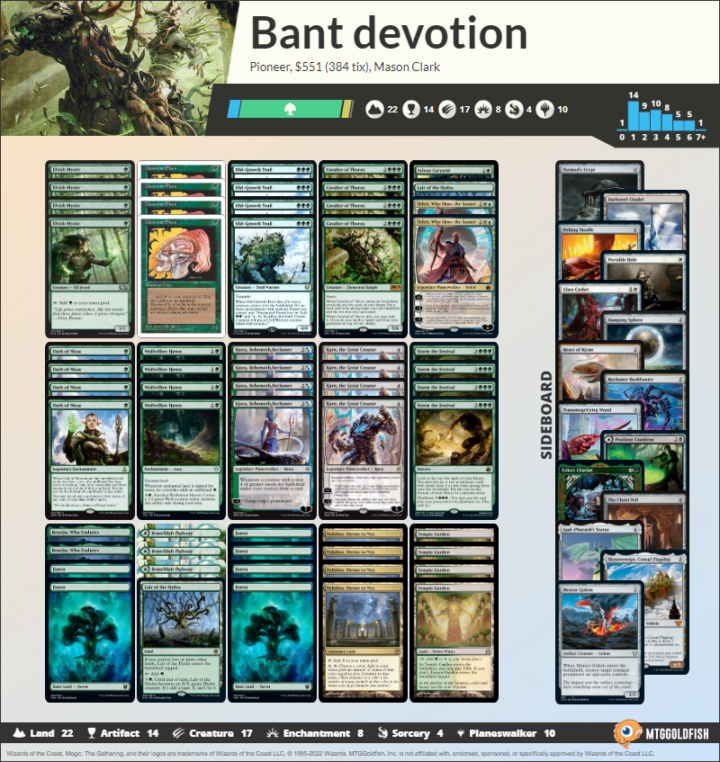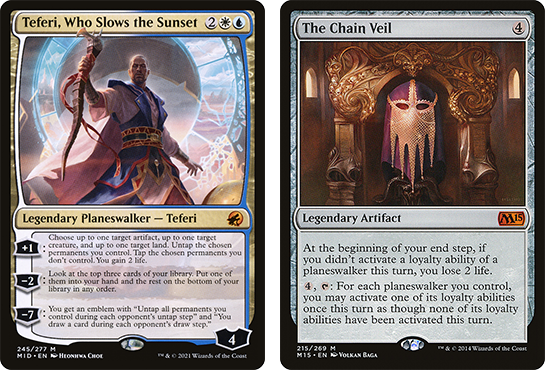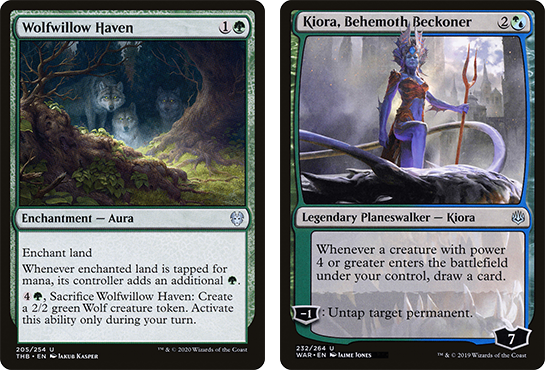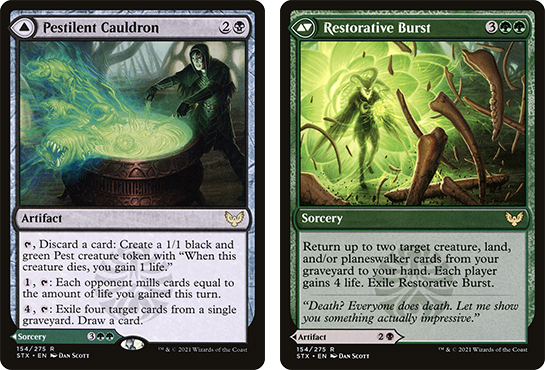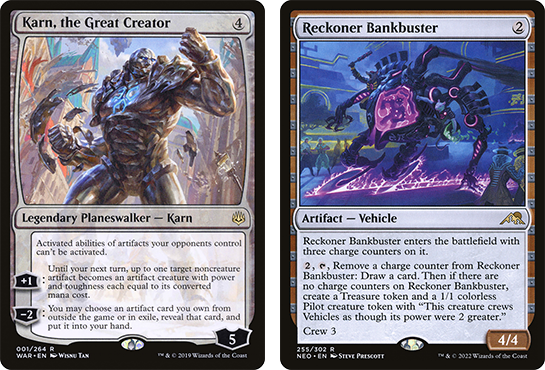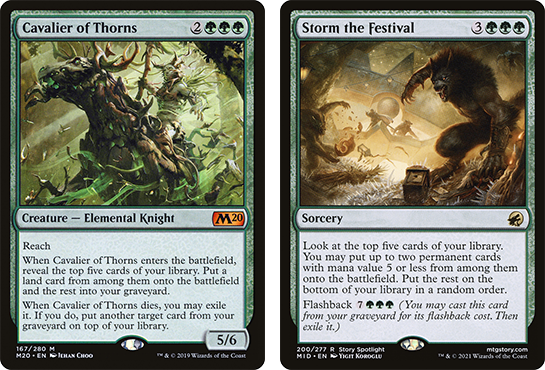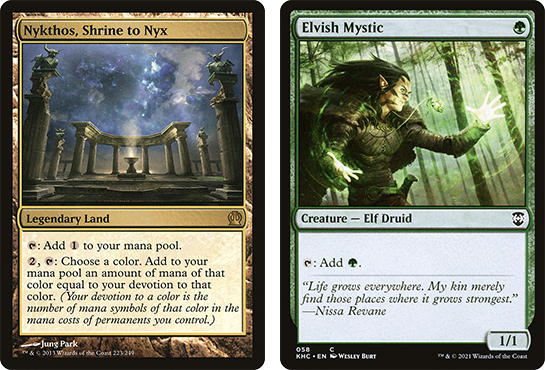Pioneer has given players a lot to talk about since the first Regional Championship will ask that players compete using the format. Yet in the months since that announcement, as players searched for something that could bring them the coveted victory, one deck has stayed on top of the metagame: Mono Green Devotion.
Since this summer, the deck has been the best or among the top three best decks every week. If you had read my tier list article from June and just played the two S-tier decks, you would have been in a great spot every week of this format
Players make a lot of excuses about why they won’t play Mono Green, but as one of the two great decks in Pioneer, we are going to confront those excuses head on and go over why you should give it a go. Then, we’ll give you a guide to help get started.
“Mono Green is just a dumb ramp deck”
Well, you’re not totally wrong. It is a green ramp deck that looks to slam big cards. However, to call the deck dumb and imply it requires little skill is very wrong.
Mulliganing is one of the hardest parts of Magic, not only for the ability to discern whether a hand is good enough but for the willpower to get rid of hands that are just fine. The green deck has some absolutely broken starts, so keeping a seven that doesn’t have something powerful going on is unacceptable.
There is also a lot of playing to maximize outs and playing the percentages. Green is much more like a combo midrange deck than a true ramp deck.
Regardless, honestly ask yourself whether it matters if it’s just a dumb ramp deck. Does that make playing this deck a bad choice? Does playing a deck that makes you look smart or that requires more thought give you extra match points? Does it mean you’re going to win more?
The answer is no on every front. So, if it’s the best deck for a weekend and your main goal is winning, put all those feelings aside.
“The combo is too hard”
While at first it’s fairly hard to understand the deck’s combo when someone explains it to you, when you see it happen at the table, it’s much easier to grok the combo. If the vanilla version is too tough, there are a few versions of the combo using Teferi, Who Slows the Sunset that makes the whole process much easier. Perhaps consider starting there.
With that in mind, let’s quickly go over an easy version of the combo.
You have a Teferi and The Chain Veil in play with six devotion for your Nykthos.
First, activate Nykthos. Now you have six mana in your pool. You can now activate The Chain Veil, which gives you one more activation of Teferi and two mana left in your pool. Then, you activate Teferi to untap Nykthos and The Chain Veil.
From there, you once again use Nykthos to make six mana then pay to activate The Chain Veil again.
You repeat this process infinitely since you now have a loop. Teferi gains you two life every time you do this, which means you now have infinite life. From that point, your opponent can’t really win.
Not to get too deep, but if you have seven devotion instead of six, you now also have infinite mana. But we will go over the combo in more detail later. That’s because even with just that basic understanding, you’re already in a great spot to win with green.
Green also wins a reasonable number of games by simply attacking people. Old-Growth Troll and Cavalier of Thorns are very large in the format and allow you to pressure the opponent very easily.
Mulliganing
When playing this deck, you need to keep hands that accelerate with early mana plays and ideally have at least one pay off card. If your opening hand doesn’t have an acceleration play in the first two turns, you are probably better off going to six cards in most matchups than keeping the hand.
The only real exception is versus Rakdos Midrange where you prefer to have an abundance of lands so as to make their removal spells less effective. Outside of that corner case, looking for a turn one elf is typically a great rule of thumb, and going to five in order to produce that hand is totally reasonable.
Yet, one question that comes up a lot is: what should you do with hands that are all in on ramp, whether you’re on the play or the draw? Do you keep them?
I think the answer is yes to both. You’re going to need to draw pay off cards in order to win, but with this much mana so early, anything you draw will be a strong play. So, while you do lose some small percent of games to never drawing a pay off, you win way more by simply drawing any of your stronger top end cards.
It’s easy to talk yourself out of these hands, but it’s very hard to get a perfect seven cards. When you have everything you need but a single pay off, you have to just accept this is something the deck will do.
Just don’t be afraid to mulligan your sevens aggressively with this deck. While you are a critical mass deck, you do need certain tools more than you need raw cards.
Sequencing
One of the most important aspects of Mono Green is maximizing your spell sequencing to not only produce the maximum amount of mana but create the most opportunities to look for the cards you want to find.
Wolfwillow Haven is a great example of this concept. This card, when played, immediately nets you a mana back if you’re able to put it on an untapped land.
Consider a situation where you have four mana available to you and you’re wanting to play Kiora this turn. You can start by playing Wolfwillow on a land and then playing your Kiora. This will also open up the option of your Kiora untapping the Wolfwillow land, which will allow you to make another play.
While an easy to understand example, it’s very possible to not catch these min/max opportunities when playing the deck — especially if you just go on autopilot. In a deck like this where you don’t have much card manipulation, you need to make up for that disadvantage by maximizing every little play you can.
It would be easy to have a whole article full of situations where you can maximize your sequencing but just take some time every turn to make sure you’re getting the most mana possible each turn while also working toward winning the game as efficiently as possible.
The Combo
Earlier in the article I walked through a very short version of the combo to gain infinite life. Now, we are going to go over the bread and butter version of the combo operating on the lowest amount of resources.
To start, if this is your board state, you win the game. Note that you can have any combination of green pips. All that really matters is having two mana to activate your Nykthos and both Karn and Kiora in play with another copy of each in the graveyard*. We are using the deck list shown above in the article for this combo if you need a reference point.
(Note*: if you don’t have extra copies in the graveyard, you will need 10 devotion for Nykthos. This will allow you to perform a similar combo to what we will go over below with the added step of grabbing Heart of Kiran. You can use its crew ability to put your singular copies of each walker into the graveyard so you can get them back and continue the loop.)
So, with the setup above, you have eight devotion. You can activate your Nykthos for eight mana, then untap your Nykthos with Kiora’s minus one ability.
Then you will reactivate your Nykthos using the eight mana floating from the first time, putting you at 14 mana. Next, you minus two your Karn and grab The Chain Veil from your sideboard.
You cast and activate your Chain Veil. This will put you to six mana left in your pool, and each of your walkers can be activated one more time. It’s also important to remember that The Chain Veil’s ability doesn’t specify planeswalkers in play. That means future copies of walkers will have two activations available to them. And, if you activate Chain Veil more times, they will have more activations.
Anyway, now that you have an extra activation of Kiora, use her minus one on Nykthos and activate the land again. This puts your current mana count to 12
Now, minus two your Karn and grab Pestilent Cauldron. This card will ultimately kill your opponent, but we are more interested in the back side right now.
Cast the back side of the Cauldron, Restorative Burst, to return Kiora and Karn from your graveyard to your hand. Your current mana count is seven.
Cast the new Kiora from hand, putting you to four mana. Minus one your new Kiora on Nykthos and then activate it, putting you to 10 mana in your pool.
Thanks to The Chain Veil, this Kiora has another minus one available. Use that on Nykthos again and activate it again, putting you to 16 mana.
Now, if you noticed, Restorative Burst exiles itself when cast. Since it’s a double face card, it goes to exile as the artifact side. That means Karn can minus two to grab it from exile.
So, cast your new Karn, putting you to 12 mana in your pool.
Minus two Karn and grab the Cauldron back. Then, cast Burst and target the Karn and Kiora that previously died to the legend rule thanks to us casting these two new copies. This will leave you with seven mana in your pool.
Now, if you noticed, we are in a very similar spot to where we were just a few steps earlier — except for one key difference: this Karn still has three loyalty. That means it can minus again to add the Cauldron to our hand.
That means it’s time to repeat some steps
Cast the new Kiora from hand, putting you to four mana. Minus one your new Kiora on Nykthos and then activate it, putting you to 10 mana in our pool.
Thanks to The Chain Veil, this Kiora has another minus one available. Use that on Nykthos again and activate it again. That gives you 16 mana.
So, now that we did that again, we are in a similar spot as when we double minused for the Cauldron — except this time we have the Cauldron already in hand.
Also, keep in mind that Restorative Burst has both players gain four life when it’s cast. This means you can repeat this process as many times as you want until both players have infinite life.
How are we going to kill them?
It’s time we finally read the front half of the Cauldron. It will mill players equal to the amount of life you have gained this turn. So, the only hurdle we have left is getting the black mana to activate it.
Once you have gained enough life to mill them out, get back to the starting position (a fresh Kiora you can cast and a Karn that can grab the Cauldron once more with one activation left. You will have 16 mana left in your pool).
Use your Karn to wish for a Reckoner Bankbuster instead of the second Cauldron. Cast Reckoner Bankbuster, putting you down to fourteen mana. Activate Bankbuster to draw a card and remove a charge counter, putting you at 12 mana.
Now, cast your fresh Kiora from hand and go to nine mana in your pool.
Minus one your Kiora on the Bankbuster, then activate it again. Repeat this process once more. After doing this twice, you will have five mana left.
Now you have a treasure thanks to Bankbuster’s ability when it has been activated three times. You will be five mana and one treasure.
Now you can cast your Cauldron and activate it to mill your opponent out.
Quick sequencing tips
If you’re going to activate Nykthos and you have an elf in hand, playing it is mana neutral and will yield more mana in the future, as long as you can still pay to activate Nykthos.
When playing Cavalier of Thorns, be aware of how many Nykthoses you have seen. If you have one in play and haven’t seen any others, you might be better off holding priority on the Cavalier trigger and activating Nykthos for mana so that if you hit another Nykthos, you don’t waste the mana.
In a similar vein to Cavalier, be aware of what you have used before casting Storm The Festival. You don’t want to be in a situation where you hit a planeswalker and realize you haven’t used the copy that’s already in play to the fullest.
Also remember that Teferi can tap opponents cards as well. This can be used to tap them out of counter magic or clear the way of a blocker so you can attack
When figuring out how much mana you will have if you activate Nykthos, untap it with Kiora and activate it again, multiply your devotion by two and subtract two. This does not count the two mana for your first Nykthos activation.
With all that said, this deck is much easier than it seems at first glance, and it’s one of the strongest decks in the format. If you’re wanting to maximize winning, take some time and play a few games with this deck. You will be pleasantly surprised with just how powerful it is.

Mason Clark is a grinder in every corner of the game who has played at the pro level and on the SCG Tour with Team Nova. Whether he’s competing in Standard, Historic or Modern, Mason plays with one goal in mind: to be a better player than he was the day before. Check out his podcast, Constructed Criticism, and catch his streams on Twitch.


